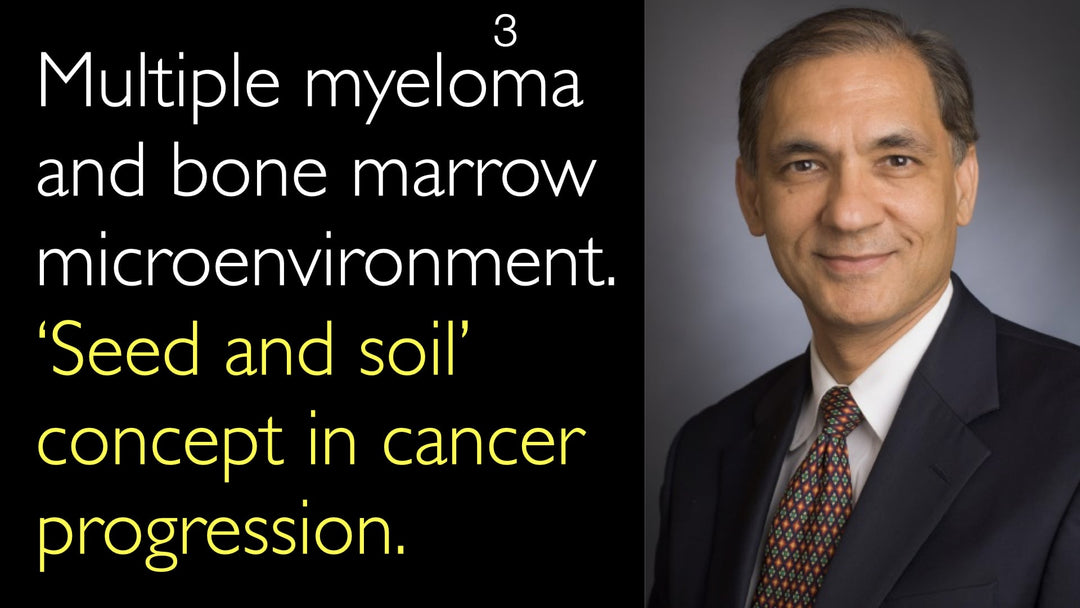Leading expert in multiple myeloma, Dr. Nikhil Munshi, MD, explains the critical role of the bone marrow microenvironment in cancer progression. He details the "seed and soil" concept where myeloma cells are the seed and the bone marrow is the soil. The microenvironment provides essential support for myeloma cell survival and growth. Modern therapies now target both the cancer cells and the surrounding microenvironment. Poisoning the soil makes it inhospitable for cancer growth. This dual approach significantly improves treatment efficacy.
Targeting the Bone Marrow Microenvironment in Multiple Myeloma Treatment
Jump To Section
- Seed and Soil Concept in Cancer
- Microenvironment Support for Myeloma
- Therapeutic Strategies: Poisoning the Soil
- How Myeloma Drugs Target the Microenvironment
- Role of the Immune Microenvironment
- Future of Microenvironment-Targeted Therapies
- Full Transcript
Seed and Soil Concept in Cancer
Dr. Nikhil Munshi, MD, describes a fundamental principle in cancer biology known as the "seed and soil" concept. The cancer cell itself is the seed. However, it requires the right soil, or microenvironment, to grow and progress. This concept is particularly emblematic in multiple myeloma. The interaction between the tumor cell and its surrounding bone marrow stroma is critical for disease development.
Microenvironment Support for Myeloma
The bone marrow microenvironment provides the essential milieu for myeloma cells to thrive. Dr. Nikhil Munshi, MD, explains that the soil offers the right food and signals for cancer growth. Laboratory evidence confirms that myeloma cells survive better and proliferate faster when in the presence of bone marrow microenvironment cells. This protective niche is a major factor in treatment resistance and disease progression.
Therapeutic Strategies: Poisoning the Soil
A key therapeutic goal is to disrupt the supportive relationship between the myeloma cell and its environment. Dr. Nikhil Munshi, MD, emphasizes the strategy of "poisoning the soil." This means altering the bone marrow microenvironment so it can no longer support myeloma cell survival and growth. By making the soil inhospitable, the cancer seed cannot flourish, even in the presence of other treatments targeting the tumor cells directly.
How Myeloma Drugs Target the Microenvironment
Modern multiple myeloma drugs achieve a dual effect. They attack the cancer cells while simultaneously changing the microenvironment. Dr. Nikhil Munshi, MD, notes that proteasome inhibitors disrupt microenvironment interactions and cytokine signaling. Immunomodulatory drugs also profoundly affect the bone marrow niche. These treatments remove the protective ability of the microenvironment. This allows for more effective killing of the tumor cells.
Role of the Immune Microenvironment
The immune cells within the bone marrow represent a critical component of the microenvironment. Dr. Nikhil Munshi, MD, highlights the immune microenvironment as a powerful tool for therapy. Harnessing these immune factors can lead to superior therapeutic efficacy. This is the foundation for many newer treatments, including monoclonal antibodies and immunotherapies, which aim to modulate the patient's own immune system to fight the cancer.
Future of Microenvironment-Targeted Therapies
The understanding of the bone marrow microenvironment is shaping the future of multiple myeloma treatment. Dr. Nikhil Munshi, MD, points to a growing arsenal of drugs that target these interactions. The continued development of antibodies and novel agents focuses on breaking the protective shield around cancer cells. This approach promises to improve outcomes and potentially prevent disease progression by fundamentally altering the cancer's home.
Full Transcript
Dr. Anton Titov, MD: Cancer progression involves an interaction between the tumor cells and the microenvironment around them. Multiple myeloma is emblematic of the impact of the cancer microenvironment on tumor cells. What is the role of the bone marrow microenvironment in multiple myeloma development, and how can it be influenced to prevent multiple myeloma development in the first place? Consequently, is it possible to somehow manipulate the microenvironment around the cancer cells with therapeutic goals?
Dr. Nikhil Munshi, MD: You have raised one of the most important questions in understanding the biology of myeloma and the therapy of myeloma. This is not a new concept. There has been a concept about "seed in the soil." To explain it simply, cancer is the seed, but it needs the right soil for it to grow and progress.
In the same way, the myeloma cell is the seed, and the bone marrow microenvironment is the soil. The soil provides the right milieu, the right food for myeloma to grow. That's literally what happens in the lab. We have shown that myeloma cells can survive much better and grow much faster when they are in the presence of the microenvironment cells.
On the other hand, for therapeutic purposes, we need to try and kill myeloma cells. We are all doing it. But equally important may be to poison the soil so the seed does not grow.
We have now begun to have drugs that do both: affect the myeloma cells but also change the microenvironment in a way that it does not support myeloma growth or survival in the presence of other treatments. We know that the bone marrow microenvironment protects myeloma cells from our drugs.
Now our drugs take away the protective ability of the microenvironment and are able to kill the tumor cells much better. This has been observed with the proteasome inhibitor by affecting the microenvironment interactions and the cytokines in the microenvironment.
It happens with immunomodulatory drugs. We observe it with a lot of other newer drugs, antibodies, and other treatments that we are beginning to utilize.
Finally, one component of the bone marrow microenvironment is the immune microenvironment. As we will discuss more in a minute, those factors, those immune cells, are actually the most critical component that we can harness for better therapeutic efficacy.




